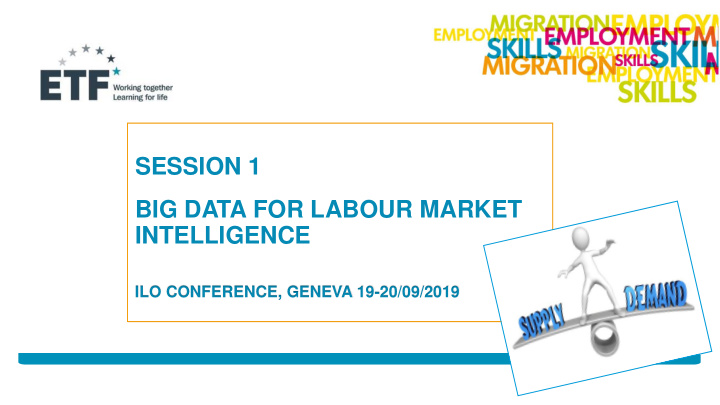



SESSION 1 BIG DATA FOR LABOUR MARKET INTELLIGENCE ILO CONFERENCE, GENEVA 19-20/09/2019
Right skills for occupations, employment: today and tomorrow 1. Transformation: hybrid skills; technical (job) specific; transversal; 2. Policy issues: skill digital; “green” skills… mismatch: gaps, shortage; over- & under-qualification; over- and underskilling; automatable tasks / occupations; reskilling; upskllling
COUNTRIES’ LMIS ARE DOING MORE AND BETTER… Data Analysis / methods • • Foresight (qualitative) Regular surveys statistical offices: LFS, • households, business, wages … Quantitative medium / long-term • forecasting LM skills Administrative data: registers • Scenario building on sectors’ • Special surveys: employers; workers; development, prospects graduates; • Analysis of skill mismatch (various • Qualitative sources: in-depth interviews types) • Job vacancies DBs, online portals • Use of Big Data analytics • Education statistical data (admission, graduates) But the question is : can the digital transformation be applied to innovate and add-value to LMIS? 4
CHALLENGES OF CONVENTIONAL LMI – CAN BIG DATA ANALYTICS HELP? Analysis Integration Detail, Usage granularity Challenges Timeliness Cost LMI 5
Big Data for LMI – Online Job Vacancies BIG DATA Large potential for analysis of labour market and skills dynamics Real-time, agile, innovative Methodology developments – and still several issues at stake
AI algorithms 7
The key elements driving the rise of Big Data: (i) data availability, (ii) ever greater computing power and (iii) recent advances in AI 8
Big Data for LMI – Online Job Vacancies https://www.burning-glass.com/ Data driven insight into the Job Market Skills-OVATE: Skills Online Vacancy Analysis Tool for Europe
ETF approach: shaping, applying and sustaining knowledge Partnering with CRISP 2. Application Research 1. Guide: in partner methodology Centre countries 4. Skills development 3. Experts' & network Knowledge- sharing
1. Guidance: methodology Aimed at statisticians, researchers, policy analysts and decision- makers in the ETF’s partner countries who are confronted with the challenges of anticipation and dissemination of insights on the dynamics of demand for jobs, skills and qualifications, this paper addresses key conceptual, methodological and organisational aspects in using Big Data for labour market intelligence. It clarifies how Big Data can be used to go beyond the frontiers of conventional approaches to labour market information systems and add value to established statistics. https://www.etf.europa.eu/en/publications-and-resources/publications/big- data-labour-market-intelligence-introductory-guide 11
1. Guidance: methodology CONTENT 1. Big Data and LMI: how to enhance LMI in the digital era – overview, state of play, potential and limitations 2. Incorporating Big Data analytics in LMI: systematic steps 3. Use of Big Data analytics for LMIS: a selection of cases to be used as practical reference 4. Conclusions and recommendations + References, sources! 12
2. Application in countries • Identification, analysis of OJV websites • Ranking and selection of suitable websites Feasibility • 2 countries: Tunisia, Morocco OJV • Data ingestion • Data processing • Front end – presentation area: visualisation Data tool • Engage national partners, experts in process data model • Discuss results / uses with national experts and stakeholders • Replicate, share experience, develop skills Sustainability
Reflections from first ETF experience Statistical offices OJV websites Discovering • In which conditions • Large variety of • Other Big Data can Big Data LMI be volume, scope; applications and used? fragmentation: sources for S kills • Can Big Data LMI mapping? • The science behind • Volume OJVs: what supplement and Big Data analytics: enrich LM statistics? issues? AI algorithms How? • Common principles • “Let the data speak”: • Capacity? for OJV information? game changer? • Cooperation public • Multidisciplinarity: and private data science + websites? domain expertise 14
Reflections from first ETF experience Informal employment and new forms of work: how to capture them with Big Data analytics? Which taxonomies, classifications of occupations and skills can be used? Skills demand analysis: is cross-country comparison important? What about supply? Build services for professionals and end-users – explore the data visualisation possibilities International collaboration and exchange 15
Thank you! www.etf.europa.eu 16
Recommend
More recommend